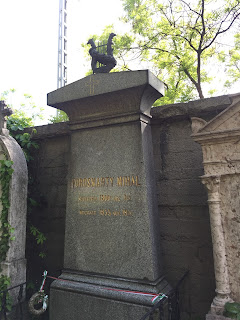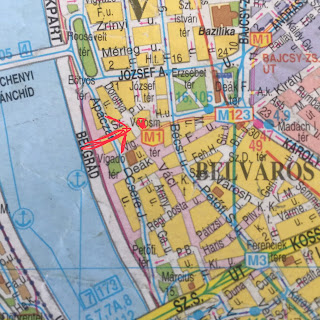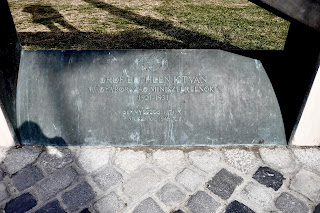A blog about the statues and busts and plaques I see as I wander about. I will start with Budapest and I hope I will eventually travel farther afield, if some time in the 2020s we are allowed to travel again.
Monday, October 11, 2021
Liverpool - Memorial to the Engineroom Staff on the Titanic
Wednesday, May 26, 2021
Mihály Vörösmarty
I am also a little disappointed. In my ignorance, I had all sorts of vague notions of his heroism and nobility, as well as half-formed imaginings about his adventurous deeds. Vörösmarty's significance is enormous to Hungarians, but to a non-Hungarian it is difficult to understand why he deserves quite such a huge monument, (and yet it must be greatly loved, as it is tenderly wrapped up against the cold every single winter).
Vörösmarty was a writer, it turns out. He composed one of the nation's favourite poems. Two lines of it are inscribed below his feet on the monument:
"Hazádnák rendületlenűl légy híve, óh magyar" - "Oh Hungarian, to your homeland be unfailingly true."
I admire any nation that reveres its poets, and Hungary apparently does.
There are twenty figures on the lower part of the monument. They represent different members of Hungarian society. Both Vörösmarty and the twenty figures are made from Carrara marble, although the base of the monument is limestone. It was erected in 1908 and buried in the base somewhere, still visible if you can find it, is a single coin, which was the donation of an extremely poor person to the fund to erect the statue. The sculptor was so moved by this re-enactment of the widow's mite that he ensured it could be seen in the finished work.
This inscription tells of a Finnish sculptor, Yrjö Liipola who lived and worked in Hungary from 1904-1934, acting as Finnish consul from 1925-1934. He was a student of the sculptor Ede Kallós, and Kallós made him the model for the flag-bearing student.
Here is Vörösmarty's grave in the Kerepesi Cemetery:
It stands directly facing the shocking remnants of the former regime:
Nearby, inexplicably always adorned with freshly brought flowers, is the grave of the thuggish Communist dictator, Matyás Rákosi. How strange that when faced with these things, I find myself suddenly in sympathy with those who wish to drag down statues and sweep away all traces of those they consider to be evil imperialists. I certainly find it insulting to someone genuinely loved by Hungarians to have these reminders of a quite different kind of Hungarian so close to where the poet lies:
Sunday, May 16, 2021
Janos Fadrusz, corner of Naphegy utca and Lisznyai utca, Krisztinavaros, Budapest
“Közelben állott Fadrusz János Műterme, ahol a Kolozsvárott felállított Mátyás Király szobrot alkotta Marton László szobrászművész ajándéka”
which I think means:
"János Fadrusz, who had a studio near here, in which he created the statue of King Matthias erected in Cluj-Napoca. This is a present from the sculptor László Márton."
Fadrusz was born in 1858 in Pozsony/Pressburg/Bratislava & died in 1903, aged only 45, in Budapest.
There is a painting of him & links to some of his sculptures here.
I found a Romanian article which contained a huge amount of information including the startling information that, in order to get a crucifixion sculpture just right, Fadrusz crucified himself, hoping that he would gain a better understanding of the experience - that is dedication.
I was delighted to discern the earnestness so typical of this end of Europe, expressed in this part of the article:
"In an editorial effort to bring back to the public opinion the personality of the sculptor Fadrusz János, little known in Romanian cultural circles, the Foto-Travel blog presented a series of articles dedicated to the 111th anniversary of the inauguration of two Fadrusz statuary groups and 110 years since the sculptor's death. This approach continues with this article dedicated to their creator, and will culminate in the coming weeks by organizing in Zalău a debate on the life and work of sculptor Fadrusz János."
A world where someone can think optimistically about organising a debate in a small rural town on the life and work of an obscure sculptor is a kinder, simpler world than the one I usually believe myself to be living in. The post is only 8 years old so I am hoping things have not changed dramatically in Zalau - although I have absolutely no appetite for seminars and lengthy discourses, I like the idea that someone does.
Here is the video of the debate. It's only an hour and a half long - and in Romanian:
That article, which for some reason I now cannot find, (although possibly it was this one), and this one both mention several sculptures by Fadrusz here in Budapest, as well as one in a little town about 100 kilometres away. I will seek them out and add photographs of them to this post over time.
The sad news is that the sculptor's early death at 45 was due to tuberculosis.
Thursday, May 13, 2021
Count István Bethlen de Bethlen, Saint George Square, the Castle District, Budapest
I have walked past this statue many times without trying to find out more about its subject, Count Istvan Bethlen de Bethlen. The statue itself didn't appeal to me and I assumed, from the fact that the inscription states that Bethlen died in Moscow, that he was a Communist crony.
What a mistake, what a lesson that one should never jump to conclusions. Bethlen, it turns out, was one of the more admirable politicians of 20th century Hungary.
Bethlen was elected to parliament in Hungary in 1901. In 1919, he served as a representative of the Hungarian government at the Paris Peace Conference.
When Béla Kun seized power in Hungary and established a Hungarian Soviet Republic, Bethlen quickly returned from Paris to Hungary to assume leadership of the anti-communist "white" government based in Szeged. After the "white" forces defeated Kun, Bethlen again took a seat in the parliament, and worked in alliance with the conservative factions there.
In 1920, after an attempt to return Charles I of Austria/IV of Hungary to the throne of Hungary was defeated, Miklós Horthy was named Regent in Hungary. After a second attempt by Charles was also unsuccessful, Horthy asked Bethlen to form a government, hoping to eliminate the possibility of further governmental upheaval. Bethlen became Prime Minister of Hungary in April, 1921. He and Horthy, rather unwisely, did get involved in negotiations with Charles I of Austria/IV of Hungary later that year, with the idea that his monarchy be restored - I hope one day to find a statue of Charles so that I can recount the absurd mess of that attempt, along with Charles's earlier ones.
Anyway, in 1922 Bethlen founded the Party of National Unity and managed to create a durable coalition between the wealthy industrialists in Budapest and the old Hungarian rural gentry. He also managed to reach agreement with the labour unions and get them to support the government, thus eliminating another source of domestic dissent.
While there is something called the Franc Affair that Bethlen almost certainly had a hand in, while he did enter into a Treaty of Friendship with Mussolini's Italy, his political efforts checked the rise of Fascism in Hungary for at least a decade, according to Wikipedia. Certainly, his removal from the Prime Ministership was caused by a shift to the right in Hungarian politics due to the Great Depression, and those who followed him were extremists - particularly Gyula Gombos de Jakfa, who was the second person after Bethlen to take over as Prime Minister in 1932; Gombos de Jakfa was a Fascist and an avowed antisemite.
Bethlen stood out as one of the few voices in Hungary actively opposed to an alliance with Nazi Germany. Late in the war, he tried without success to negotiate a separate peace with the Allied powers. When the Soviets moved in, the Hungarian communists re-emerged from the woodwork. Bethlen was a threat, having proved himself a man who could unite disparate political forces. In March 1945, he was arrested by the Soviets and taken to Moscow. He died there in prison on 5 October 1946.
Bethlen and the Hungarian delegation - to what? - in the Hague
Princess August Marie Louise Katherina of Saxe-Weimar-Eisenach, later Queen of Prussia and Empress of Germany - Baden Baden
I came across this statue in Baden Baden, in the Lichtenauer Allee. It is the work of Joseph von Kopf and was erected in 1892. It is dedicat...

-
I came across this statue in Baden Baden, in the Lichtenauer Allee. It is the work of Joseph von Kopf and was erected in 1892. It is dedicat...
-
Next time I go to Liverpool, I will try to take some better photographs of this moving memorial, commissioned by the White Star Line of Live...
-
I have walked past this statue many times without trying to find out more about its subject, Count Istvan Bethlen de Bethlen. The statue its...




































